|
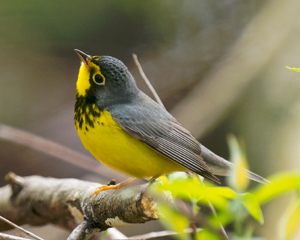 My friend Mike having caught the travel bug, he came to me one day enthusing about Magee Marsh, which he had seen on the internet. I therefore organised a
trip, but it rapidly became apparent that it would be worthwhile, and very easy, to visit the famous Point Pelee as well. We read several trip reports, including
those from travel companies, some of which visit both places, and we thought we could do it far more cheaply, apart from the fact we prefer to bird alone.
(Ann doesn't mind as long as she doesn't want to do the trip). It was simply a case of booking flights, motels and car hire all online,
and off we went.
My friend Mike having caught the travel bug, he came to me one day enthusing about Magee Marsh, which he had seen on the internet. I therefore organised a
trip, but it rapidly became apparent that it would be worthwhile, and very easy, to visit the famous Point Pelee as well. We read several trip reports, including
those from travel companies, some of which visit both places, and we thought we could do it far more cheaply, apart from the fact we prefer to bird alone.
(Ann doesn't mind as long as she doesn't want to do the trip). It was simply a case of booking flights, motels and car hire all online,
and off we went.
A few things I should mention if you want to do the same. Firstly, Pelee is in Canada and Magee in Ohio USA, we found it cheapest to fly in and out of
Toronto, and this makes things easier logistically, since it means the route can be planned more easily, being the Easternmost point we wanted to visit, and
there was little "retracing of steps". Secondly, entering the USA by land, as will be seen later, can cause an hour or more's delay, so plan the journey accordingly.
Birders are much the same wherever, but I did have to ask for a translation of directions from French at Pelee. The guy actually apologised!
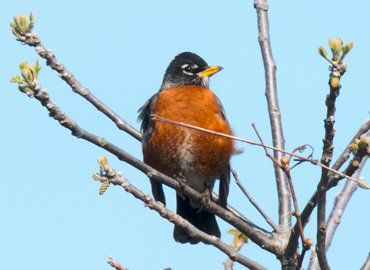 Monday 7th May
We landed in Toronto where a new computerised system had been installed to check passports etc. Still needed people to show you what the instructions meant!
As time goes on more people will be used to it and it will be a lot quicker, and we cleared customs quickly anyway.
Our next stop, at the car hire, was a case of good news, bad news.
The bad news was they had no cars in the category we had pre-booked. However, after rejecting two VW Beetles and a people carrier, we were offered a Nissan
which looked nice and a bit larger than the compact we had ordered. The good news was it had a 3.5 litre turbocharged engine and electric everything,
a top of the range Maxima, no extra charge. (No, Mike we can't ship it home, and you couldn't drive it properly in Norfolk nowadays anyway).
All this didn't help with the early evening traffic, but we covered the 170 miles to our first motel quite quickly having left the city limits, and had time
for something to eat on the way. We did see a few common species en route, plus our only sighting of Broad-winged Hawk, and even had time for an hour or
so's birding at the back of the motel, where we saw our first warblers, a couple of Yellow Warblers. Of course, warbler migration is the main reason for
visiting this area, although there are many other interesting species also migrating, or resident. So, going with the flow, we were aiming for thirty,
twenty-nine to go!
Monday 7th May
We landed in Toronto where a new computerised system had been installed to check passports etc. Still needed people to show you what the instructions meant!
As time goes on more people will be used to it and it will be a lot quicker, and we cleared customs quickly anyway.
Our next stop, at the car hire, was a case of good news, bad news.
The bad news was they had no cars in the category we had pre-booked. However, after rejecting two VW Beetles and a people carrier, we were offered a Nissan
which looked nice and a bit larger than the compact we had ordered. The good news was it had a 3.5 litre turbocharged engine and electric everything,
a top of the range Maxima, no extra charge. (No, Mike we can't ship it home, and you couldn't drive it properly in Norfolk nowadays anyway).
All this didn't help with the early evening traffic, but we covered the 170 miles to our first motel quite quickly having left the city limits, and had time
for something to eat on the way. We did see a few common species en route, plus our only sighting of Broad-winged Hawk, and even had time for an hour or
so's birding at the back of the motel, where we saw our first warblers, a couple of Yellow Warblers. Of course, warbler migration is the main reason for
visiting this area, although there are many other interesting species also migrating, or resident. So, going with the flow, we were aiming for thirty,
twenty-nine to go!
 Tuesday 8th May
Up early the next day, we returned to the area around the motel briefly before making our way to Rondeau Park. A Cliff Swallow was a good bird for the list,
since they are quite scarce in the area, although there are small colonies as will be seen later. Killdeer, American Robin and Song Sparrows ensured
we knew where we were, and before long we drove to Rondeau which was quite close by. A logistical note here, most motels now have some form of breakfast
available, usually from an early hour, but if you want substantial you'll have to get it later. Near the two hotspots of Magee and Pelee, most motels
do a very early start, from 4am. We're not that fanatical, in fact we found more good birds later in the day, but if you bowl up mid-morning you may have
trouble parking. Pelee famously has a shuttle bus to the "point", but on our first visit we had to park in an overflow car park and get a shuttle to the
shuttle! This is also somewhat dependent on conditions, since if a good fall is expected everyone that is anyone tries to get to the point by dawn.
Tuesday 8th May
Up early the next day, we returned to the area around the motel briefly before making our way to Rondeau Park. A Cliff Swallow was a good bird for the list,
since they are quite scarce in the area, although there are small colonies as will be seen later. Killdeer, American Robin and Song Sparrows ensured
we knew where we were, and before long we drove to Rondeau which was quite close by. A logistical note here, most motels now have some form of breakfast
available, usually from an early hour, but if you want substantial you'll have to get it later. Near the two hotspots of Magee and Pelee, most motels
do a very early start, from 4am. We're not that fanatical, in fact we found more good birds later in the day, but if you bowl up mid-morning you may have
trouble parking. Pelee famously has a shuttle bus to the "point", but on our first visit we had to park in an overflow car park and get a shuttle to the
shuttle! This is also somewhat dependent on conditions, since if a good fall is expected everyone that is anyone tries to get to the point by dawn.
We chose to visit Rondeau for two reasons, firstly it was conveniently placed and mentioned favourably in many tour reports, secondly we felt it would
give us a relatively quiet introduction to birding in the area, rather than the situation of "not knowing where to look next". In this we were proved
right on both matters, a thirty minute journey in the morning found us at the park entrance. Like most US and Canadian wildlife parks there are several trails,
usually easy but can become flooded, and large nuumbers of warning notices about about ticks and other hazards. Whilst the risk isn't great, it is
advisable to take the usual precautions. Rondeau can attract large numbers of birds
if there's a fall, that wasn't the case today, but our second American warbler soon came in the shape of American Redstart, a male. We spent the
rest of the day there, it being only a short drive (in the direction of Pelee) to our next motel. Nothing exceptional was seen, it used to be a reliable site for
Cerulean Warbler but sadly this is no longer the case as their numbers are in freefall, it was in fact the only (regular) warbler we missed. White-eyed
Vireo was a good find, our only one of the trip, although had we not seen it at Rondeau I'm sure we could have found one later. Thrushes were much in
evidence, all the Catharus species plus a late afternoon, somewhat distant Wood Thrush. Other warblers included Northern Parula, and Prothonotary,
which is a breeder in the area and often missed at Pelee and Magee. A short boardwalk at Rondeau leads to a promontary where we did a little
"seawatching", yes, Lake Erie is that big, although one of the smaller Great Lakes, and ducks, grebes and divers pass on migration.
A Solitary Sandpiper was seen briefly, and a Spotted Sandpiper
for a bit longer, we suspected a flock of White-winged Scoter but they were just too distant to clinch the ID. Just off the boardwalk we recorded a
photogenic Field Sparrow, our only one of the trip, and made our way eventually to our motel for the night, in striking distance of Point Pelee, having
had an excellent first day without being overwhelmed
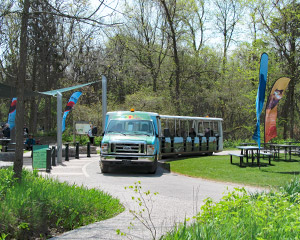
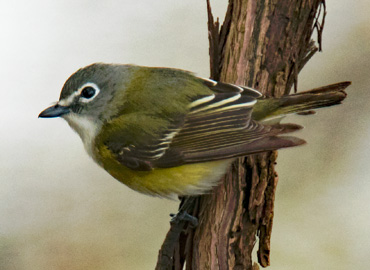 Wednesday 9th May
As the weather was good the next day we didn't see any need to be at Pelee very early, so we got there about nine. Our predictions were obviously not
quite accurate, since this turned out to be the day of two shuttle buses, and by the time we got to the point it was already crowded. However it was
already crowded with birds as well, and we realised why the point was so popular. Most arrivals land at the point and make their way inland, but many
feed up first, and the viewing conditions are more open. There is also a "reverse migration" which no-one has been able to explain, whereby birds
fly in the opposite direction and out over Lake Erie again. This all adds up to birds everywhere basically, mainly warblers but also flycatchers,
thrushes, vireos, even woodpeckers. In our first hour our warbler tally climbed to double figures, all in breeding plumage (with a few late first-winters)
Wednesday 9th May
As the weather was good the next day we didn't see any need to be at Pelee very early, so we got there about nine. Our predictions were obviously not
quite accurate, since this turned out to be the day of two shuttle buses, and by the time we got to the point it was already crowded. However it was
already crowded with birds as well, and we realised why the point was so popular. Most arrivals land at the point and make their way inland, but many
feed up first, and the viewing conditions are more open. There is also a "reverse migration" which no-one has been able to explain, whereby birds
fly in the opposite direction and out over Lake Erie again. This all adds up to birds everywhere basically, mainly warblers but also flycatchers,
thrushes, vireos, even woodpeckers. In our first hour our warbler tally climbed to double figures, all in breeding plumage (with a few late first-winters)
We then slowly made our way back to the visitor centre, birding en-route, having decided already that Pelee was all it was cracked up to be
and more. Pelee is much bigger than Magee, basically consisting of the whole promontary, and has a number of trails which seem to attract different
species. A few vireos and warblers breed in the area among other things, but it's basically all about migration. Warblers came thick and fast at the
point, many at point-blank range and oblivious to the crowds, being too busy feeding to worry about the mass firing of camera shutters. Our warbler
list increased by fourteen in almost the same number of minutes, but nobody was looking at watches! This is why people come here, one of the best
bird spectacles on earth, no craning of necks waiting for a brief passage of a feeding flock in the rainforest, no sitting for hours behind a telescope
looking out on an empty sea. I hardly used my bins, I was too busy taking photos. I used a 400mm lens, but the 1.4 converter stayed in my pocket.
Mike, meanwhile, was ecstatic, but had to worry about something, this being the lack of Blackburnian Warbler, one of his "most-wanted". In one of life's
strange anomalies, we didn't see one that day, although one or two were reported. He soon put it to the back of his mind as we made our way very
slowly back to the visitor centre, a walk of about two kilometers on the main path, more if you investigate the trails leading off, which we did. By
early afternoon our list included four species of Vireo, three Flycatchers, five thrushes, four Sparrows, two Orioles and a Tanager, plus the warblers,
and that's just the passerines.
At the visitor center there is a sightings board, which is generally a good source of information, although it's not always clear when a bird was seen,
and it may well have moved on. The other problem at both Pelee and Magee is that, although there are crowds, many of them come for the spectacle and
the camaraderie rather than the birds themselves, and unfortunately aren't always good birders. We rapidly "sussed this out", and decided to find
as much as possible for ourselves, particularly after stopping at one or two gatherings to be told they were looking for something we'd already seen
plenty of. By day two we were showing the "locals" the less common species like Canada and Wilson's Warblers, although there were obviously many good
birders there who put us on to birds as well. This strategy nearly cost us a tick but there did seem to be a lot of activity at one particular
junction, so we went to the information board at the visitor centre, which was close by, to discover we'd walked past a Kentucky Warbler! It had been in
the area a few days so we didn't panic, just went back to the crowd.
Another peculiarity of most American birders is that most are impatient, if a bird doesn't show they move on, so when we asked for directions to the
bird a typical comment was "I don't know, I haven't been here long". Eventually I got some info, and a few minutes after standing at what we thought was
a good spot, our quarry was sited not far away, moving in our direction.
 Kentucky Warblers are a ground-nesting species, and as such are deemed "skulkers", although this is really a consequence of their preferred habitat than
anything else. I rapidly decided I was unlikely to get a photo, so we settled for a decent, if brief, view of what was a good tick for us both. At least
we saw the diagnostic head pattern. We decided to spend the afternoon to the north of the visitor centre, because birds work their way inland as I said before.
Whilst we didn't see many new species, one of the highlights was a Wood Thrush and a Veery around the same log. Yellow-bellied Flycatcher was new, but
as Mike had already decided to leave all the Empidonax flycatchers to me I wasn't totally happy with the ID and decided to wait for a more classic
bird. (Fair enough- Mike's doing the female warblers!) We ended our first day at Pelee with the warbler list on 18, but strangely hadn't yet seen Northern
Parula there, nor Blackburnian at all.Driving inland from the point is the famous Hillman Marsh, which we duly visited. We weren't totally
impressed, as birds tended to be distant and there were few waders. However, it is a migration stopover for many species, and can vary from day to day, so
we resolved to give it another try. There is an entry fee (as for many parks in Canada including Pelee) but we decided paying once was enough, so future
visits were after five o'clock, when the gate wasn't manned. Birds we did see on that first evening included Least Sandpiper, Lesser Yellowlegs and
Bonaparte's Gull, Caspian and Forster's Terns, and Ruddy Duck. All in all it was a fantastic day, the crowds weren't as bad as we'd feared and there are
always trails which are much quieter. Of course, we'd seen many species I haven't mentioned, one of the first was Wild Turkey on the drive in, and the
first bird we saw waiting for the first shuttle was a Scarlet Tanager. Plus our only Belted Kingfisher of the trip flew south.
Our list for the day totalled about seventy, and we retired, after a decent meal in a
restaurant which was walking distance from our motel, anticipating the next day when we could concentrate on finding new birds, or better views of some already
seen, not that many fell in to that category.
Kentucky Warblers are a ground-nesting species, and as such are deemed "skulkers", although this is really a consequence of their preferred habitat than
anything else. I rapidly decided I was unlikely to get a photo, so we settled for a decent, if brief, view of what was a good tick for us both. At least
we saw the diagnostic head pattern. We decided to spend the afternoon to the north of the visitor centre, because birds work their way inland as I said before.
Whilst we didn't see many new species, one of the highlights was a Wood Thrush and a Veery around the same log. Yellow-bellied Flycatcher was new, but
as Mike had already decided to leave all the Empidonax flycatchers to me I wasn't totally happy with the ID and decided to wait for a more classic
bird. (Fair enough- Mike's doing the female warblers!) We ended our first day at Pelee with the warbler list on 18, but strangely hadn't yet seen Northern
Parula there, nor Blackburnian at all.Driving inland from the point is the famous Hillman Marsh, which we duly visited. We weren't totally
impressed, as birds tended to be distant and there were few waders. However, it is a migration stopover for many species, and can vary from day to day, so
we resolved to give it another try. There is an entry fee (as for many parks in Canada including Pelee) but we decided paying once was enough, so future
visits were after five o'clock, when the gate wasn't manned. Birds we did see on that first evening included Least Sandpiper, Lesser Yellowlegs and
Bonaparte's Gull, Caspian and Forster's Terns, and Ruddy Duck. All in all it was a fantastic day, the crowds weren't as bad as we'd feared and there are
always trails which are much quieter. Of course, we'd seen many species I haven't mentioned, one of the first was Wild Turkey on the drive in, and the
first bird we saw waiting for the first shuttle was a Scarlet Tanager. Plus our only Belted Kingfisher of the trip flew south.
Our list for the day totalled about seventy, and we retired, after a decent meal in a
restaurant which was walking distance from our motel, anticipating the next day when we could concentrate on finding new birds, or better views of some already
seen, not that many fell in to that category.
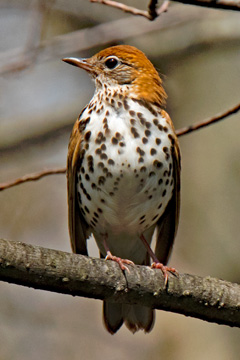
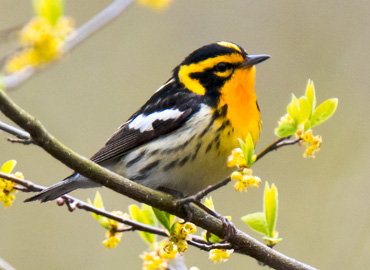 Thursday 10th May
The next day saw us getting up a bit earlier, to be at the point much sooner since we were able to park near the visitor centre. Here Mike ticked
American Pelican which had been there the previous day but flown off before we arrived. Also just off the point were Slavonian (Horned in american) Grebe,
and Great Northern Diver (Common Loon). Our first Green Heron flew over, then we resumed looking for warblers. Baltimore and Orchard Orioles were much in
evidence, and we added Orange-crowned Warbler to the list (has anyone ever seen the orange crown?). Our second Blue-winged Warbler proved photographable,
but only just, despite finding about four in the course of the trip I never got a really decent shot. However, the same can't be said for Mike's favourite,
Blackburnian Warbler, of which we saw several in our first hour, some at eye level. Very different to the previous day! Our first Blackpolls appeared,
again very photogenic, our first Northern Parulas at Pelee, and a Hooded Warbler or two which were the only ones of the trip. I don't know why we never
see Hooded Warblers very well, perhaps it's some sort of jinx, but we had exactly the same experience in North Carolina last year. They're not particularly
difficult skulkers, but never seem to stop moving, so by the time you've had a decent view and put the camera up, they've gone. I'm sure I'll get a photo
one day. We didn't get many other new species that day, although we didn't really care, such was the migration spectacle, and by evening the warbler list
had gone up to twenty two. We didn't bother with Hillman Marsh, as we had a bit of a drive to our next motel in Port Clinton, ideally placed for Magee
Marsh. Unfortunately the drive, although not especially long, involved crossing the border in to the USA. I had expected to be held up, but unfortunately
our arrival co-incided with that of a so-called "disruptive element", which means anyone who doesn't consent to being treated like dirt by the customs
officials. They are trained in that way, but cannot seemingly distinguish between genuine travellers and potential criminals. Suffice to say I was nearly
arrested for asking why we were sitting and being ignored, and I had to kick Mike "under the table" to stop him saying something he might regret later in
jail! I can understand why they are like they are, just go with the flow and you will eventually pass into the USA after about an hour, unless you are
indeed smuggling guns, narcotics or sex workers! One small point, even though you have your ESTA (visa) paid online, there is a further fee of about
seven dollars to issue necessary documentation. All this was soon forgotten and we were just getting our normal good humour back when we discovered the
main interstate highway south, which we needed to take, was closed for about ten miles! Again, once we had stopped trying to follow the satnav which
tried to take us in to some very dodgy looking areas, we found the diversion which ran parallel to the highway, and slow moving traffic was all we had
to contend with, so that we were past Detroit by early evening and booked in to the motel at a reasonable time.
Thursday 10th May
The next day saw us getting up a bit earlier, to be at the point much sooner since we were able to park near the visitor centre. Here Mike ticked
American Pelican which had been there the previous day but flown off before we arrived. Also just off the point were Slavonian (Horned in american) Grebe,
and Great Northern Diver (Common Loon). Our first Green Heron flew over, then we resumed looking for warblers. Baltimore and Orchard Orioles were much in
evidence, and we added Orange-crowned Warbler to the list (has anyone ever seen the orange crown?). Our second Blue-winged Warbler proved photographable,
but only just, despite finding about four in the course of the trip I never got a really decent shot. However, the same can't be said for Mike's favourite,
Blackburnian Warbler, of which we saw several in our first hour, some at eye level. Very different to the previous day! Our first Blackpolls appeared,
again very photogenic, our first Northern Parulas at Pelee, and a Hooded Warbler or two which were the only ones of the trip. I don't know why we never
see Hooded Warblers very well, perhaps it's some sort of jinx, but we had exactly the same experience in North Carolina last year. They're not particularly
difficult skulkers, but never seem to stop moving, so by the time you've had a decent view and put the camera up, they've gone. I'm sure I'll get a photo
one day. We didn't get many other new species that day, although we didn't really care, such was the migration spectacle, and by evening the warbler list
had gone up to twenty two. We didn't bother with Hillman Marsh, as we had a bit of a drive to our next motel in Port Clinton, ideally placed for Magee
Marsh. Unfortunately the drive, although not especially long, involved crossing the border in to the USA. I had expected to be held up, but unfortunately
our arrival co-incided with that of a so-called "disruptive element", which means anyone who doesn't consent to being treated like dirt by the customs
officials. They are trained in that way, but cannot seemingly distinguish between genuine travellers and potential criminals. Suffice to say I was nearly
arrested for asking why we were sitting and being ignored, and I had to kick Mike "under the table" to stop him saying something he might regret later in
jail! I can understand why they are like they are, just go with the flow and you will eventually pass into the USA after about an hour, unless you are
indeed smuggling guns, narcotics or sex workers! One small point, even though you have your ESTA (visa) paid online, there is a further fee of about
seven dollars to issue necessary documentation. All this was soon forgotten and we were just getting our normal good humour back when we discovered the
main interstate highway south, which we needed to take, was closed for about ten miles! Again, once we had stopped trying to follow the satnav which
tried to take us in to some very dodgy looking areas, we found the diversion which ran parallel to the highway, and slow moving traffic was all we had
to contend with, so that we were past Detroit by early evening and booked in to the motel at a reasonable time.
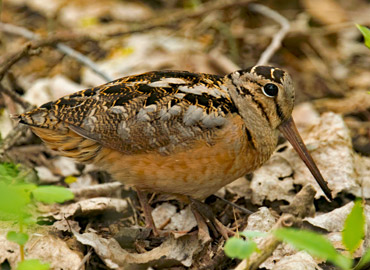 Friday 11th May
We awoke to the sound of an American Robin singing on the wire outside our room, and decided it to be a good omen. We were at this motel for five nights,
intending to visit Magee and surrounding areas. The motel, in Port Clinton is quite used to birders, as are most in the area, and we found it to be more than adequate for
our needs. Breakfast wasn't special, but available from a very early hour, and several places to eat were within walking distance. I know it to be used by
more than one tour company, but the whole area gets booked up well in advance of "Bird Festival" time, so if you want to do the same thing as us plan early,
up to a year in advance. There'll always be some accomodation, but prices tend to rise as availablity falls, especially for the "big week" which is usually
reckoned to be the second week in May.
We arrived at Magee fairly early, there was still plenty of room in the car park, which is pretty large. Very different in several ways to Pelee, it is much
smaller and doesn't have a visitor centre, just a few marquees in the car park. There is one main trail which is a boardwalk for much of its distance,
with a loop at the end, and several smaller trails, most of which are loops also. The total distance is probably a couple of miles, all of which means two
main things, more crowds but closer birds. In truth, although the beginning of the trail is quite crowded, the further you go from the entrance the less the
crowding. Near the start is a small tower, which gives excellent views of any warblers in the vicinity. It is often completely taken over by photographers,
who will sit there all day waiting for the perfect shot, then find someone to identify it for them! If that's what they want to do, fine, and to be fair
they don't flush birds or trespass, so it all works quite well. Plenty of others carry cameras, and again I saw little need to use a converter, on occasion
birds were too close to even focus! We came across a section of boardwalk temporarily deserted, and an American Redstart hopped along it towards us! The beginning of the
boardwalk has almost a carnival atmosphere, many visitors don't even have binoculars, but everyone's happy and willing to chat. The one exception is the
numbers of Amish birders, not that they are unfriendly but will not speak first. However, they do seem to be excellent birders and are quite willing to
answer questions. As we visited hotspots around Magee we saw the same people quite frequently, the Amish often seemed to be the only ones who knew what they
were doing. Another big difference is that there are numbers of people giving out information, at the time of our visit a number were from a company
called Tropical Birding, presumably it provides publicity for them but they were extremely helpful and knew what they were talking about. Having tried to
join crowds a few times with little success, we decided to look for our own, as the new species were likely to be fewer this was far more enjoyable, and
resulted in us finding a Canada Warbler. The Northern Waterthrush we had a little help from the Tropical Birding lads, and our first Ovenbird we more or less
couldn't avoid since its admirers were blocking the entrance track about fifty feet from the car park. However, bird of the day was the one bird I had really
wanted to see, not a warbler but a wader, albeit one that doesn't often wade. This was my last North (and South) American wader in the form of American
Woodcock. Three things set it apart from Eurasian Woodcock, firstly it was far more colourful, with an orange breast and yellow-orange tones in the plumage.
Secondly, it was quite happy sitting out in the open, seemingly unflustered by the crowds only feet away, and thirdly, it actually was quite active, even
beginning feeding at one point in the middle of the morning. So close to the path was it that I had to wait for people to move on to get the right angle for
a photo, since there was grass and small shrubs around. However, I did get some superb close-ups and it was still in the same area a few hours later. Its
behaviour was probably due to the fact of its being a newly arrived migrant, although they do breed in the area, and have bred at Magee itself I believe.
As with any migration point, numbers and locations vary from year to year, they're not always sat next to the path, indeed we saw two others during our
stay but both in flight and neither relocated (not that we tried hard).
Friday 11th May
We awoke to the sound of an American Robin singing on the wire outside our room, and decided it to be a good omen. We were at this motel for five nights,
intending to visit Magee and surrounding areas. The motel, in Port Clinton is quite used to birders, as are most in the area, and we found it to be more than adequate for
our needs. Breakfast wasn't special, but available from a very early hour, and several places to eat were within walking distance. I know it to be used by
more than one tour company, but the whole area gets booked up well in advance of "Bird Festival" time, so if you want to do the same thing as us plan early,
up to a year in advance. There'll always be some accomodation, but prices tend to rise as availablity falls, especially for the "big week" which is usually
reckoned to be the second week in May.
We arrived at Magee fairly early, there was still plenty of room in the car park, which is pretty large. Very different in several ways to Pelee, it is much
smaller and doesn't have a visitor centre, just a few marquees in the car park. There is one main trail which is a boardwalk for much of its distance,
with a loop at the end, and several smaller trails, most of which are loops also. The total distance is probably a couple of miles, all of which means two
main things, more crowds but closer birds. In truth, although the beginning of the trail is quite crowded, the further you go from the entrance the less the
crowding. Near the start is a small tower, which gives excellent views of any warblers in the vicinity. It is often completely taken over by photographers,
who will sit there all day waiting for the perfect shot, then find someone to identify it for them! If that's what they want to do, fine, and to be fair
they don't flush birds or trespass, so it all works quite well. Plenty of others carry cameras, and again I saw little need to use a converter, on occasion
birds were too close to even focus! We came across a section of boardwalk temporarily deserted, and an American Redstart hopped along it towards us! The beginning of the
boardwalk has almost a carnival atmosphere, many visitors don't even have binoculars, but everyone's happy and willing to chat. The one exception is the
numbers of Amish birders, not that they are unfriendly but will not speak first. However, they do seem to be excellent birders and are quite willing to
answer questions. As we visited hotspots around Magee we saw the same people quite frequently, the Amish often seemed to be the only ones who knew what they
were doing. Another big difference is that there are numbers of people giving out information, at the time of our visit a number were from a company
called Tropical Birding, presumably it provides publicity for them but they were extremely helpful and knew what they were talking about. Having tried to
join crowds a few times with little success, we decided to look for our own, as the new species were likely to be fewer this was far more enjoyable, and
resulted in us finding a Canada Warbler. The Northern Waterthrush we had a little help from the Tropical Birding lads, and our first Ovenbird we more or less
couldn't avoid since its admirers were blocking the entrance track about fifty feet from the car park. However, bird of the day was the one bird I had really
wanted to see, not a warbler but a wader, albeit one that doesn't often wade. This was my last North (and South) American wader in the form of American
Woodcock. Three things set it apart from Eurasian Woodcock, firstly it was far more colourful, with an orange breast and yellow-orange tones in the plumage.
Secondly, it was quite happy sitting out in the open, seemingly unflustered by the crowds only feet away, and thirdly, it actually was quite active, even
beginning feeding at one point in the middle of the morning. So close to the path was it that I had to wait for people to move on to get the right angle for
a photo, since there was grass and small shrubs around. However, I did get some superb close-ups and it was still in the same area a few hours later. Its
behaviour was probably due to the fact of its being a newly arrived migrant, although they do breed in the area, and have bred at Magee itself I believe.
As with any migration point, numbers and locations vary from year to year, they're not always sat next to the path, indeed we saw two others during our
stay but both in flight and neither relocated (not that we tried hard).
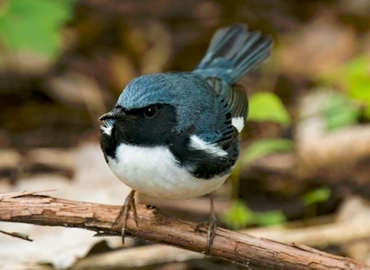 We decided to visit Metzger Marsh in the afternoon, one of the places we had heard much about. This is part of the Ottowa National Wildlife Preserve, which
adjoins Magee and is a much larger area. In truth it was a bit of an anticlimax, there is a wildlife drive but it is only open about once a month, and whilst there were
birds to be seen in the open parts much was very distant. We did manage some good views of Horned (Shore) Lark, our only sighting of American Golden Plover,
a distant Wilson's Phalarope and a few Least Sandpipers, but that was about it. Most of the ducks had departed, but that obviously varies from year to year.
However, just north of the marsh is a small copse which "can be very good", so we decided to give it a try. As we approached we saw a small crowd, not
looking in the trees but in a small area of reeds. We recognised a couple of Amish girls from Magee, so thought it was probably worth investigation, and
discovered a Least Bittern! Views weren't brilliant, but at least we didn't have to wait hours to see if it would fly out, as it was only a few feet from the
road. We then turned our attention to the copse, and found twelve species of warbler in what seemed like about six trees. Indeed very good. Nothing was new
but everything gave really good views. Our warbler count at the end of the day had risen to twenty-five.
Saturday 12th May
The next day was more or less a repeat of Friday, but there had been a change of migrants overnight. The next warbler to fall was Wilson's, and we joined
several small crowds but it seemed the bird had always moved on. Eventually, after a brief view, we found our own and had good views of this sometimes
elusive species (they never seem to stop moving). Not much else was new at Magee, and we were told by a couple of Americans that the wildlife drive at
Metzger was open that afternoon, so decided to give it a try. Whether this was a scheduled opening or not we don't know, but the presence of two
Black-necked Stilts attracted a fair bit of attention. These are apparently a rarity in the area, obviously they may have been a prospecting pair. The
wildlife drive allowed a closer view of several species, including our only Hooded Mergansers of the trip. Our first Northern Harrier passed over, and on
the lake with the stilts were a number of Greater and Lesser Yellowlegs, Semi-palmated Sandpipers were also new for the trip.
We decided to visit Metzger Marsh in the afternoon, one of the places we had heard much about. This is part of the Ottowa National Wildlife Preserve, which
adjoins Magee and is a much larger area. In truth it was a bit of an anticlimax, there is a wildlife drive but it is only open about once a month, and whilst there were
birds to be seen in the open parts much was very distant. We did manage some good views of Horned (Shore) Lark, our only sighting of American Golden Plover,
a distant Wilson's Phalarope and a few Least Sandpipers, but that was about it. Most of the ducks had departed, but that obviously varies from year to year.
However, just north of the marsh is a small copse which "can be very good", so we decided to give it a try. As we approached we saw a small crowd, not
looking in the trees but in a small area of reeds. We recognised a couple of Amish girls from Magee, so thought it was probably worth investigation, and
discovered a Least Bittern! Views weren't brilliant, but at least we didn't have to wait hours to see if it would fly out, as it was only a few feet from the
road. We then turned our attention to the copse, and found twelve species of warbler in what seemed like about six trees. Indeed very good. Nothing was new
but everything gave really good views. Our warbler count at the end of the day had risen to twenty-five.
Saturday 12th May
The next day was more or less a repeat of Friday, but there had been a change of migrants overnight. The next warbler to fall was Wilson's, and we joined
several small crowds but it seemed the bird had always moved on. Eventually, after a brief view, we found our own and had good views of this sometimes
elusive species (they never seem to stop moving). Not much else was new at Magee, and we were told by a couple of Americans that the wildlife drive at
Metzger was open that afternoon, so decided to give it a try. Whether this was a scheduled opening or not we don't know, but the presence of two
Black-necked Stilts attracted a fair bit of attention. These are apparently a rarity in the area, obviously they may have been a prospecting pair. The
wildlife drive allowed a closer view of several species, including our only Hooded Mergansers of the trip. Our first Northern Harrier passed over, and on
the lake with the stilts were a number of Greater and Lesser Yellowlegs, Semi-palmated Sandpipers were also new for the trip.
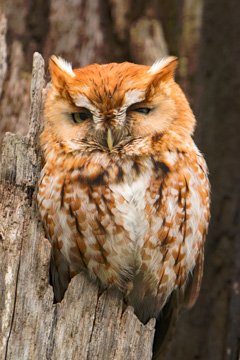 Sunday 13th May
Today we planned an early visit to Magee, and then to visit other sites in the area. Once again the birds had changed somewhat at the marsh, catharus
thrushes were again in evidence, plus birds such as Blue Jay, American Goldfinch and Purple Martin which we hadn't seen there previously, but overall there
was only one new bird for the trip in the shape of Indigo Bunting, so we didn't stay too long, particularly as nothing of interest to us appeared on the information board. We had heard of a
couple of sites in the area which were worth a visit, the first was a small area of "prairie" grassland which had been preserved. The reason for our visit
was the otherwise difficult Henslow's Sparrow, but as the weather wasn't too good we only stopped briefly, intending to return on our way back.
The second place was part of a complex which included a golf course, but there was still plenty of wildlife habitat and a really good visitor centre where
they were giving away CD's and booklets of Warblers and Owls in Michigan. The staff here were very helpful and gave us the locations of
all the Eastern Screech Owl nestboxes on the reserve, which was our main reason for visiting. Walking the trails we soon found the nestboxes, which were close
to the path, but no sign of any owls. We walked up and down as there was one box we hadn't located, but still no luck, so we continued to the end of the
boardwalk to see what else the place had to offer. We flushed a Virginia Rail (the whole area was quite swampy) which gave a good if brief flight view, and
had good views of a Marsh Wren. The
place seemed alive with Common Yellowthroats, many of which were singing males, and more easily photographed than the migrants at Magee. At the end of the
boardwalk was a viewing ramp from where we hoped we might see Sandhill Cranes, but although we heard them none came in to view. We did see a couple of Soras
however, and then returned in the hope that an owl might have appeared. No luck, but we were almost back to the visitor centre when we saw a local birder
(quite a rarity, the're all at Magee!). He pointed out that the hand-drawn map the girl had given us was not quite right, the nest box was down a side track
from the main boardwalk. We'd seen that track, why we hadn't investigated it I don't know, but it was quite short and didn't seem to lead anywhere. About
ten yards in there was a bend, and as we rounded it we could see, sitting on a stump just above head-height, an Eastern Screech-Owl in broad daylight!
Furthermore it was a rufous bird, the rarer and more attractive morph. Yet again I had to remove the converter and stand back to photograph it, but it was
the best view of an owl I've ever had. The male bird was obviously keeping an eye on the nestbox, which was just further down on the opposite side of the
track, and we managed to catch a glimpse of the (grey morph) female and an owlet within. Before we left we were treated to the sight of an American
father sending his son in to the swamp to retrieve his phone, which he had managed to drop! It was retrieved, and was apparently waterproof, but it was an
amusing diversion.Returning to Magee we stopped off at Adam Grimm Prairie again, and this time did manage a few brief views of Henslow's Sparrows, which
unfortunately weren't in singing mood (when they sit on the tops of grasses). Magee hadn't changed much since the morning, but someone had found a bird at
roost which was attracting a lot of attention, mainly because people were having difficulty picking it out in its favoured tree. No such problems for Brits,
we watched what was our third Eastern Screech Owl of the day, another grey morph, and managed a good record shot.
Sunday 13th May
Today we planned an early visit to Magee, and then to visit other sites in the area. Once again the birds had changed somewhat at the marsh, catharus
thrushes were again in evidence, plus birds such as Blue Jay, American Goldfinch and Purple Martin which we hadn't seen there previously, but overall there
was only one new bird for the trip in the shape of Indigo Bunting, so we didn't stay too long, particularly as nothing of interest to us appeared on the information board. We had heard of a
couple of sites in the area which were worth a visit, the first was a small area of "prairie" grassland which had been preserved. The reason for our visit
was the otherwise difficult Henslow's Sparrow, but as the weather wasn't too good we only stopped briefly, intending to return on our way back.
The second place was part of a complex which included a golf course, but there was still plenty of wildlife habitat and a really good visitor centre where
they were giving away CD's and booklets of Warblers and Owls in Michigan. The staff here were very helpful and gave us the locations of
all the Eastern Screech Owl nestboxes on the reserve, which was our main reason for visiting. Walking the trails we soon found the nestboxes, which were close
to the path, but no sign of any owls. We walked up and down as there was one box we hadn't located, but still no luck, so we continued to the end of the
boardwalk to see what else the place had to offer. We flushed a Virginia Rail (the whole area was quite swampy) which gave a good if brief flight view, and
had good views of a Marsh Wren. The
place seemed alive with Common Yellowthroats, many of which were singing males, and more easily photographed than the migrants at Magee. At the end of the
boardwalk was a viewing ramp from where we hoped we might see Sandhill Cranes, but although we heard them none came in to view. We did see a couple of Soras
however, and then returned in the hope that an owl might have appeared. No luck, but we were almost back to the visitor centre when we saw a local birder
(quite a rarity, the're all at Magee!). He pointed out that the hand-drawn map the girl had given us was not quite right, the nest box was down a side track
from the main boardwalk. We'd seen that track, why we hadn't investigated it I don't know, but it was quite short and didn't seem to lead anywhere. About
ten yards in there was a bend, and as we rounded it we could see, sitting on a stump just above head-height, an Eastern Screech-Owl in broad daylight!
Furthermore it was a rufous bird, the rarer and more attractive morph. Yet again I had to remove the converter and stand back to photograph it, but it was
the best view of an owl I've ever had. The male bird was obviously keeping an eye on the nestbox, which was just further down on the opposite side of the
track, and we managed to catch a glimpse of the (grey morph) female and an owlet within. Before we left we were treated to the sight of an American
father sending his son in to the swamp to retrieve his phone, which he had managed to drop! It was retrieved, and was apparently waterproof, but it was an
amusing diversion.Returning to Magee we stopped off at Adam Grimm Prairie again, and this time did manage a few brief views of Henslow's Sparrows, which
unfortunately weren't in singing mood (when they sit on the tops of grasses). Magee hadn't changed much since the morning, but someone had found a bird at
roost which was attracting a lot of attention, mainly because people were having difficulty picking it out in its favoured tree. No such problems for Brits,
we watched what was our third Eastern Screech Owl of the day, another grey morph, and managed a good record shot.
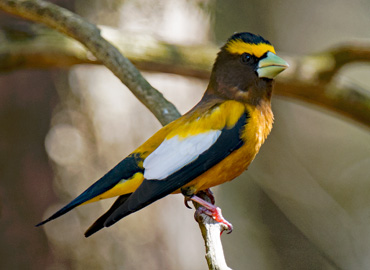 Monday 14th May
Today was to be our last day at Magee, as we intended visiting in the morning and then driving north to the town of Grayling. We wanted to join a Kirtland's
Warbler tour and Grayling is the nearest convenient town. Many tour groups do this since, although Kirtland's Warblers are recorded at Magee and Pelee
occasionally, the chances of being there at the right time are slim to say the least, and as they have such a restricted breeding range it is far easier to
join the ranger. Magee that morning was a washout, heavy rain being the culprit. We sat for a while in the car park as a few very wet people came and went,
there didn't seem to be much excitement so we decided to leave early. This in fact turned out to be a very good move, since we had a relaxed journey north,
time to stop for food, and the rain began clearing in the early afternoon. Before going to our motel we had decided to visit a place called Hardwick Pines,
about ten miles further on. This is something few tours seem to do, but for the sake of a short detour we easily saw numbers of our target bird, the
colourful Evening Grosbeak, coming to feeders right outside the visitor centre. Comparison with Rose-breasted Grosbeaks at the same feeders was interesting,
Evening being much the bulkier of the two with a massive bill. Also Pine siskins were in evidence, new for the trip, and we had arrived early enough to go
for a wander around the reserve itself. In fact we saw little away from the feeders, Hairy Woodpecker, Eastern Phoebe and Scarlet Tanager was about it, but
we did record another warbler for the trip, Pine Warbler, and our only Red-shouldered Hawk circled above in a clearing in the trees. Well satisfied with the
Grosbeaks, we went to our motel in anticipation of an early start the next day.
Monday 14th May
Today was to be our last day at Magee, as we intended visiting in the morning and then driving north to the town of Grayling. We wanted to join a Kirtland's
Warbler tour and Grayling is the nearest convenient town. Many tour groups do this since, although Kirtland's Warblers are recorded at Magee and Pelee
occasionally, the chances of being there at the right time are slim to say the least, and as they have such a restricted breeding range it is far easier to
join the ranger. Magee that morning was a washout, heavy rain being the culprit. We sat for a while in the car park as a few very wet people came and went,
there didn't seem to be much excitement so we decided to leave early. This in fact turned out to be a very good move, since we had a relaxed journey north,
time to stop for food, and the rain began clearing in the early afternoon. Before going to our motel we had decided to visit a place called Hardwick Pines,
about ten miles further on. This is something few tours seem to do, but for the sake of a short detour we easily saw numbers of our target bird, the
colourful Evening Grosbeak, coming to feeders right outside the visitor centre. Comparison with Rose-breasted Grosbeaks at the same feeders was interesting,
Evening being much the bulkier of the two with a massive bill. Also Pine siskins were in evidence, new for the trip, and we had arrived early enough to go
for a wander around the reserve itself. In fact we saw little away from the feeders, Hairy Woodpecker, Eastern Phoebe and Scarlet Tanager was about it, but
we did record another warbler for the trip, Pine Warbler, and our only Red-shouldered Hawk circled above in a clearing in the trees. Well satisfied with the
Grosbeaks, we went to our motel in anticipation of an early start the next day.
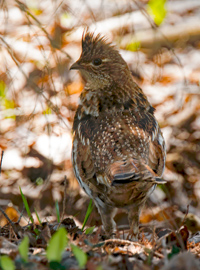
 Tuesday 15th May
The reason for visiting this part of Michigan, as I said before, was to see the very range-restricted Kirtland's Warbler. Although it is perfectly possible
to look for them by driving the roads in the area, leaving the road is discouraged so tours are organised to take as many vehicles as turn up to a spot
where birds are known to hold territory, and accompanied by a ranger you can walk in to the habitat. These "tours" are quite cheap, and save a lot of time
and effort, unfortunately the first one this year wasn't until today, which necessitated planning around it, but that was no problem. There were two tours,
obviously the early one would be better, so we arrived at the ranger station before 7am, about an hour's drive from the motel. After a short introductory
talk we all followed the ranger in convoy for quite some distance before halting at the side of the road. We all had a quick scan around, being surrounded
by the young Jack Pines in which these birds breed, and had a new bird for the trip, a Vesper Sparrow. No warblers however, so the warden led us along a
narrow path to a spot about one hundred yards in, where we stood and within a few minutes were treated to a singing Kirtland's Warbler. The bird was close
enough for a record shot, and may have been visible very distantly from the road, but joining the ranger really made sense. We had a second and third
sighting a little later, probably the same bird, but then returned to the road so as to cause no further disturbance. Later in the season more birds would
probably have been in evidence, but we had seen our target so we were happy. We chose to drive back to the ranger station where we purchased a couple
of souvenir t-shirts, and received free fluffy toy Kirtland's Warblers with them, which sing on being pressed. Big kids that we are, we've both still got
them! There is in the area a Ruffed Grouse trail, but it was closed. Having read many tour reports that missed this species, we asked the ranger, to
which she replied "I often see them driving to work in the early morning" Obviously it's very much pot luck, and people often report hearing them but being
unable to see them. However luck was obviously on our side, as in the course of our travels (I can't remember where but the forest covers a huge area) we
saw one at the roadside. We drew slowly to a halt, expecting it to flush, but it walked about a yard in to the forest and stood there while I took a
photograph.
Tuesday 15th May
The reason for visiting this part of Michigan, as I said before, was to see the very range-restricted Kirtland's Warbler. Although it is perfectly possible
to look for them by driving the roads in the area, leaving the road is discouraged so tours are organised to take as many vehicles as turn up to a spot
where birds are known to hold territory, and accompanied by a ranger you can walk in to the habitat. These "tours" are quite cheap, and save a lot of time
and effort, unfortunately the first one this year wasn't until today, which necessitated planning around it, but that was no problem. There were two tours,
obviously the early one would be better, so we arrived at the ranger station before 7am, about an hour's drive from the motel. After a short introductory
talk we all followed the ranger in convoy for quite some distance before halting at the side of the road. We all had a quick scan around, being surrounded
by the young Jack Pines in which these birds breed, and had a new bird for the trip, a Vesper Sparrow. No warblers however, so the warden led us along a
narrow path to a spot about one hundred yards in, where we stood and within a few minutes were treated to a singing Kirtland's Warbler. The bird was close
enough for a record shot, and may have been visible very distantly from the road, but joining the ranger really made sense. We had a second and third
sighting a little later, probably the same bird, but then returned to the road so as to cause no further disturbance. Later in the season more birds would
probably have been in evidence, but we had seen our target so we were happy. We chose to drive back to the ranger station where we purchased a couple
of souvenir t-shirts, and received free fluffy toy Kirtland's Warblers with them, which sing on being pressed. Big kids that we are, we've both still got
them! There is in the area a Ruffed Grouse trail, but it was closed. Having read many tour reports that missed this species, we asked the ranger, to
which she replied "I often see them driving to work in the early morning" Obviously it's very much pot luck, and people often report hearing them but being
unable to see them. However luck was obviously on our side, as in the course of our travels (I can't remember where but the forest covers a huge area) we
saw one at the roadside. We drew slowly to a halt, expecting it to flush, but it walked about a yard in to the forest and stood there while I took a
photograph.
 Wednesday 16th May
Our next port of call, which we actually arrived at the previous afternoon, was another migration hotspot, Point Tawas. We had heard of it from friends who
had been there the previous year, and whilst nowhere near as popular as Magee or Pelee, often turns up birds which the others don't get. One of these was a
Snowy Owl, which we missed by a day, but others more than compensated for it. For some reason this site is good for Golden-winged Warbler, which neither of
us had seen since the infamous Tesco car park bird thirty years previously. We saw one fairly early in the morning, and a probable hybrid later. A bird
which should have been easy but proved somewhat elusive was Bobolink, which we were told were usually around the grassy are by the lighthouse but weren't.
We did however have good views of Clay-coloured Sparrow, which we hadn't seen at Pelee or Magee.
On our way to the tip of the small peninsular (or on the way back) we saw a trio of flycatchers which were new for the trip, namely Eastern Wood Pewee,
Eastern Kingbird and Great Crested Flycatcher. At the tip itself there were several sandbanks which, as well as showing us where the snowy owl was no longer,
gave us a few additions to our list, Hudsonian Whimbrel, Sanderling and Short-billed Dowitcher. Incoming Indigo Buntings also showed well.
Sand Martin was also new, and a Merlin showed well if briefly
on several occasions, particularly welcome as the American race is a potential split. A showy Green Heron allowed some decent photos, and as we walked back
the Bobolinks finally put in an appearence, although they didn't stop long. We had particularly wanted to see them as we'd both seen immature birds in the UK,
but breeding males are so very different with their black, yellow and white plumage.
Wednesday 16th May
Our next port of call, which we actually arrived at the previous afternoon, was another migration hotspot, Point Tawas. We had heard of it from friends who
had been there the previous year, and whilst nowhere near as popular as Magee or Pelee, often turns up birds which the others don't get. One of these was a
Snowy Owl, which we missed by a day, but others more than compensated for it. For some reason this site is good for Golden-winged Warbler, which neither of
us had seen since the infamous Tesco car park bird thirty years previously. We saw one fairly early in the morning, and a probable hybrid later. A bird
which should have been easy but proved somewhat elusive was Bobolink, which we were told were usually around the grassy are by the lighthouse but weren't.
We did however have good views of Clay-coloured Sparrow, which we hadn't seen at Pelee or Magee.
On our way to the tip of the small peninsular (or on the way back) we saw a trio of flycatchers which were new for the trip, namely Eastern Wood Pewee,
Eastern Kingbird and Great Crested Flycatcher. At the tip itself there were several sandbanks which, as well as showing us where the snowy owl was no longer,
gave us a few additions to our list, Hudsonian Whimbrel, Sanderling and Short-billed Dowitcher. Incoming Indigo Buntings also showed well.
Sand Martin was also new, and a Merlin showed well if briefly
on several occasions, particularly welcome as the American race is a potential split. A showy Green Heron allowed some decent photos, and as we walked back
the Bobolinks finally put in an appearence, although they didn't stop long. We had particularly wanted to see them as we'd both seen immature birds in the UK,
but breeding males are so very different with their black, yellow and white plumage.
Thursday 17th May
We revisited Tawas in the morning in the hope of something new before starting our journey back to Pelee. We had decided on revisiting Pelee rather than Magee
for several reasons, not least of which was we had been away from there for longer thus increasing the chances of something new. Our warbler tally was twenty eight,
very respectable but we wanted thirty! Tawas that morning wasn't the place unfortunately, so we continued via Tuttle Marsh, on the shores of Lake St Clair which
is just north of Detroit. This is a site for Yellow-headed Blackbird
which is declining in the area and another species the tour groups tend to ignore. On arrival we found another large wetland and marsh area, where we saw
Caspian and Forster's Terns, and eventually several Yellow-headed Blackbirds. Distant views in the main unfortunately, but one did actually fly over us from behind, so a
longer time there would probably have paid off. As we left the area we had to suddenly stop the car as three Sandhill Cranes were coming in to land. This was
a new bird for the trip, although not uncommon in the area. Driving back we again had to cross the border, but entering Canada is a very different proposition.
We stopped at a booth similar to a toll, and after a few questions from a very friendly lady, and inspection of our passports, we continued towards Pelee.
On arrival in the area we decided on a return visit to Hillman Marsh, which turned out to
be holding far more birds than on our previous visit, including large numbers of Bonaparte's Gulls in all plumages. They obviously moult later than some, so
breeding adults were few, but enough to satisfy us. Someone tried to claim a Little Gull, which is a rarity for the area, but although it was obvious which
bird they were talking about it sadly wasn't one. More waders were present, including large numbers of Black-bellied (Grey) Plovers, many of which were in
breeding plumage, and Short-billed Dowitcher and Wilson's Phalarope were close enough to get record shots. Flyovers today had included Cooper's Hawk,
Bald Eagle and Northern Harrier, so we deemed it not at all bad for a "travel" day, and checked in at our motel.
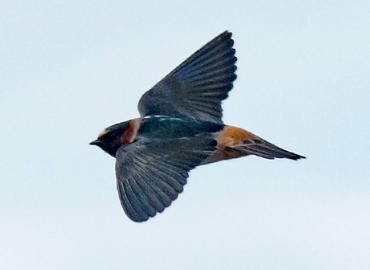
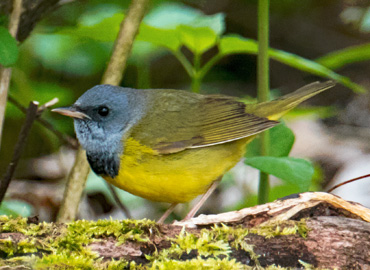 Friday 18th & Saturday 19th May
A different motel was used on our return, a bit more upmarket but still very bird-orientated, offering breakfast from 4am. The large photo of a Northern Cardinal
on our floor rapidly became boring, especially with all the warblers to choose from, but at least they made an effort, showing what a big boost to their
economy Pelee must be. Every year nearly all the hotels in the area are booked weeks in advance, so if you want to do your own thing book in plenty of time.
The next two days we spent at Pelee, and the mix of species had indeed changed. Many warblers were the same, although some numbers were down; Canada Warblers
and Wilson's in particular were more numerous and gave some really good views. Also more numerous were vireos, and we had superb views of both Red-eyed and
Philadelphia. Yellow-throated, Blue-headed and Warbling were also much in evidence, whilst a new bird for the trip came in the shape of Eastern Bluebird,
presumably a later migrant. Also of note were a close Great Northern Diver in breeding plumage, and an American Otter. We heard several reports of a
Mississippi Kite being in the area, which we tended to view with a pinch of salt as it's a rarity at Pelee, but as we drove out on our first day it flew,
unmistakeable as they are, right over the car along the track. We stopped and tried to follow it as it veered out over the water, but sadly lost it.
However we did report it the next morning to give credence to earlier sightings, as no-one saw it perched.
We thought we had missed our warbler target until there were three reports of Mourning Warbler on the second day. However,
they tend to be skulkers and although we both managed a brief view they were hardly tickable. Our consciences were taxed even more when we found a
Yellow-breasted Chat, which is now classed as a Warbler. Anyway, a definite twenty-nine! On both days we visited Hillman Marsh in the evening but saw
little new, however on our last day in the area we decided, as it was somewhat early and we were waiting for the gate to be unmanned,
to drive around the local area to see what we could find. We drove to
another point on the lakeshore but the lake was empty in all directions, so we drove a bit further along the edge. Still nothing, but as we turned to walk
back to the car we saw a Cliff Swallow, then another, and another, and the penny dropped. We were next to a bridge over an irrigation canal, and where do
Cliff Swallows nest? We had found a colony of this uncommon (in the area) breeder. We couldn't see all the nests, but estimated 15-20. The birds often
seemed to act in unison, at one moment they were all attending their nests and the sky was empty, the next it was full of birds. Whilst watching and trying
to photograph the swallows, we were treated to the sight of two Bald Eagles seemingly fighting almost overhead, yet another spectacle. After some time we
called in briefly to Hillman Marsh, not much had changed except many of the Bonaparte's Gulls and some waders had moved on, so it was back to the motel to
make plans for our last day.
Friday 18th & Saturday 19th May
A different motel was used on our return, a bit more upmarket but still very bird-orientated, offering breakfast from 4am. The large photo of a Northern Cardinal
on our floor rapidly became boring, especially with all the warblers to choose from, but at least they made an effort, showing what a big boost to their
economy Pelee must be. Every year nearly all the hotels in the area are booked weeks in advance, so if you want to do your own thing book in plenty of time.
The next two days we spent at Pelee, and the mix of species had indeed changed. Many warblers were the same, although some numbers were down; Canada Warblers
and Wilson's in particular were more numerous and gave some really good views. Also more numerous were vireos, and we had superb views of both Red-eyed and
Philadelphia. Yellow-throated, Blue-headed and Warbling were also much in evidence, whilst a new bird for the trip came in the shape of Eastern Bluebird,
presumably a later migrant. Also of note were a close Great Northern Diver in breeding plumage, and an American Otter. We heard several reports of a
Mississippi Kite being in the area, which we tended to view with a pinch of salt as it's a rarity at Pelee, but as we drove out on our first day it flew,
unmistakeable as they are, right over the car along the track. We stopped and tried to follow it as it veered out over the water, but sadly lost it.
However we did report it the next morning to give credence to earlier sightings, as no-one saw it perched.
We thought we had missed our warbler target until there were three reports of Mourning Warbler on the second day. However,
they tend to be skulkers and although we both managed a brief view they were hardly tickable. Our consciences were taxed even more when we found a
Yellow-breasted Chat, which is now classed as a Warbler. Anyway, a definite twenty-nine! On both days we visited Hillman Marsh in the evening but saw
little new, however on our last day in the area we decided, as it was somewhat early and we were waiting for the gate to be unmanned,
to drive around the local area to see what we could find. We drove to
another point on the lakeshore but the lake was empty in all directions, so we drove a bit further along the edge. Still nothing, but as we turned to walk
back to the car we saw a Cliff Swallow, then another, and another, and the penny dropped. We were next to a bridge over an irrigation canal, and where do
Cliff Swallows nest? We had found a colony of this uncommon (in the area) breeder. We couldn't see all the nests, but estimated 15-20. The birds often
seemed to act in unison, at one moment they were all attending their nests and the sky was empty, the next it was full of birds. Whilst watching and trying
to photograph the swallows, we were treated to the sight of two Bald Eagles seemingly fighting almost overhead, yet another spectacle. After some time we
called in briefly to Hillman Marsh, not much had changed except many of the Bonaparte's Gulls and some waders had moved on, so it was back to the motel to
make plans for our last day.
Sunday 20th May
Our flight home wasn't until 10pm, and as Pelee was closer to the airport than Magee this would give us plenty of birding time. We decided to revisit Rondeau,
as it was more or less on our route back, and this proved to be an inspired choice. We had hoped for Cerulean Warbler, as several pairs used to breed at the
park, but the species has undergone a dramatic decline and gone from being almost certain to a rarity in the area. Birds do still breed, but the numbers are so
low you have to be very lucky, and we weren't! We saw several species of warbler, numbers of birds were well up on our previous visit, we met birders who
knew what they were talking about, there were no crowds, and we had a very enjoyable day. Flycatchers were quite numerous as well as warblers, and we saw
a few species uncommon elsewhere such as American Goldfinch, Black-capped Chickadee and White-breasted Nuthatch. Part way through the morning we visited an
area with a disused building and an overgrown mound where a female American Redstart was performing admirably, and as I consider them to be as attractive as
the male I spent some time photographing it. Like many birds it had a little "circuit" and whilst waiting for a re-appearence I turned round to look at the
area behind. Suddenly the rotten log had a Mourning Warbler on it! I called Mike as I photographed it, and he also managed good views. Unfortunately for the
birders a few yards away it quickly disappeared in to the undergrowth, and we didn't see it again. Having helped for a while we left the (now) group, hopefully
it did reappear. At last-thirty species of warbler with no dodgy sightings! Amazingly, Mike found another later in the day, but true to form, although views were
good it soon melted into cover.
Highly chuffed, we had to leave for the airport soon after, but everything went smoothly and after an overnight flight we arrived back at Gatwick with plenty
of time to drive home in daylight.
|
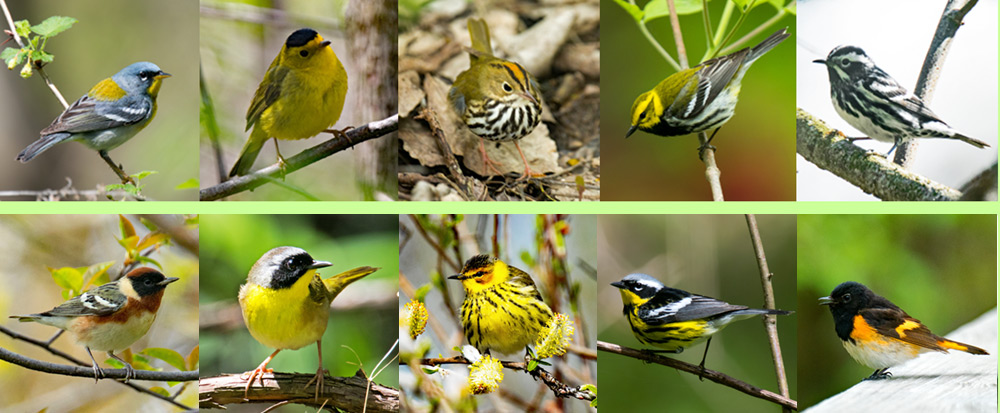
|
My account of our very succesful trip may sound as if I don't like tour groups. I don't want to give that impression and have been on several group tours myself,
but many people can't afford them, and doing your own thing gives much more flexibility. Many people prefer tours as they don't have to do any planning, or
driving etc., but those "going it alone" usually make use of trip reports, many thanks to those whose trip reports we read.
This area is perfect for
both inexperienced and experienced birders, it would make a good first trip to the states, as the birding is quite easy. It's like a "mega-Scilly", but with
hundreds more birds (and birders!). Perhaps the biggest problem if you are a dedicated twitcher is that having seen numerous Grey Catbirds, say, can you
really raise the enthusiasm to drive to Cornwall to see another? Rather topical that one! Another observation is that like any migration hotspot, you
don't see the same birds each year, although the variety is so good that you'll only miss a few. This year among the birds we didn't see were the two North American
cuckoos, Black and Yellow-billed. Only a very few were being reported, and we missed them. One major rarity for the USA was seen at the time we were there,
but we can live without Tree Sparrow! But forget the unexpected, forget numbers, the sheer spectacle of hundreds of North American Wood Warblers at close
range is one of the best birding experiences you can have. Of the two main sites, if I had to choose it would be Pelee, as it's larger and better organised,
but if you're visiting one you might as well visit both, and don't forget the less popular sites such as Rondeau, and Tawas Point if you're going north for
Kirtland's Warbler. Should you have more time or have been before there are other excellent sites not too far away, such as Whitefish Point, where many owls are
ringed annually, and Algonquin National Park, which will afford more boreal species including Moose.
|








